

Compact Muon Solenoid
LHC, CERN
| CMS-B2G-20-010 ; CERN-EP-2021-223 | ||
| Search for a heavy resonance decaying into a top quark and a W boson in the lepton+jets final state at $\sqrt{s} = $ 13 TeV | ||
| CMS Collaboration | ||
| 19 November 2021 | ||
| JHEP 04 (2022) 048 | ||
| Abstract: A search for a heavy resonance decaying into a top quark and a W boson in proton-proton collisions at $\sqrt{s} = $ 13 TeV is presented. The data analyzed were recorded with the CMS detector at the LHC and correspond to an integrated luminosity of 138 fb$^{-1}$. The top quark is reconstructed as a single jet and the W boson, from its decay into an electron or muon and the corresponding neutrino. A top quark tagging technique based on jet clustering with a variable distance parameter and simultaneous jet grooming is used to identify jets from the collimated top quark decay. The results are interpreted in the context of two benchmark models, where the heavy resonance is either an excited bottom quark b* or a vector-like quark B. A statistical combination with an earlier search by the CMS Collaboration in the all-hadronic final state is performed to place upper cross section limits on these two models. The new analysis extends the lower range of resonance mass probed from 1.4 down to 0.7 TeV. For left-handed, right-handed, and vector-like couplings, b* masses up to 3.0, 3.0, and 3.2 TeV are excluded at 95% confidence level, respectively. The observed upper limits represent the most stringent constraints on the b* model to date. | ||
| Links: e-print arXiv:2111.10216 [hep-ex] (PDF) ; CDS record ; inSPIRE record ; HepData record ; CADI line (restricted) ; | ||
| Figures & Tables | Summary | Additional Figures | References | CMS Publications |
|---|
| Figures | |

png pdf |
Figure 1:
Example Feynman diagrams at LO of the production and decay of a {\mathrm{b} ^\ast} (left) and a \PB quark (right), drawn with the TikZ-Feynman package [10]. |
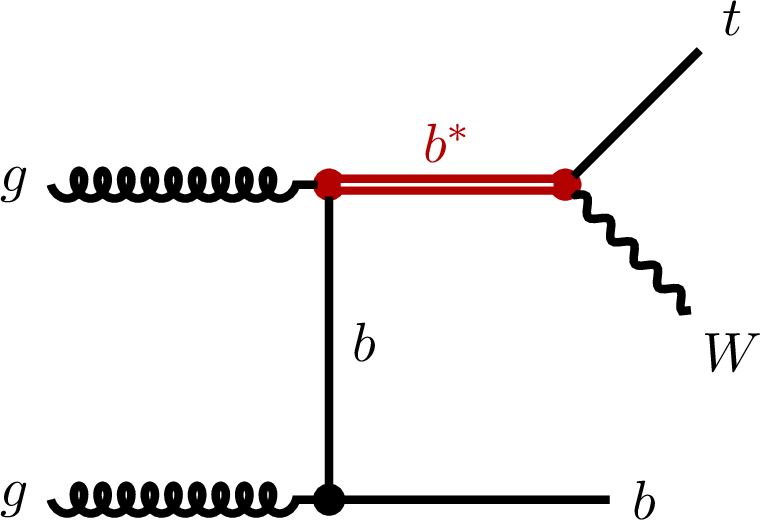
png pdf |
Figure 1-a:
Example Feynman diagram at LO of the production and decay of a b* quark, drawn with the TikZ-Feynman package [10]. |

png pdf |
Figure 1-b:
Example Feynman diagram at LO of the production and decay of a B quark, drawn with the TikZ-Feynman package [10]. |
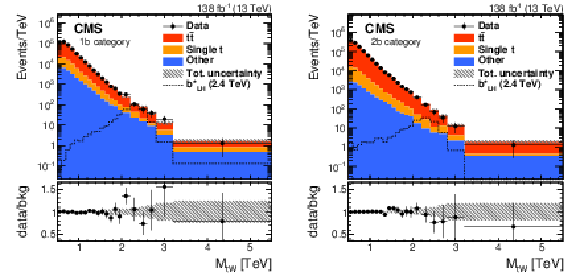
png pdf |
Figure 2:
Distributions of ${M_{\mathrm{t} \mathrm{W}}}$ in the 1b (left) and 2b (right) categories. The data are shown by filled markers, where the horizontal bars indicate the bin widths. The individual background contributions are given by filled histograms. The expected signal for an LH b* with a mass of $m_{{\mathrm{b} ^*}} = $ 2.4 TeV is shown by a dashed line. The shaded region is the uncertainty in the total background estimate. The lower panels of each figure show the ratio of data to the background estimate, with the total uncertainty in the predicted background displayed as shaded band. |

png pdf |
Figure 2-a:
Distribution of ${M_{\mathrm{t} \mathrm{W}}}$ in the 1b category. The data are shown by filled markers, where the horizontal bars indicate the bin widths. The individual background contributions are given by filled histograms. The expected signal for an LH b* with a mass of $m_{{\mathrm{b} ^*}} = $ 2.4 TeV is shown by a dashed line. The shaded region is the uncertainty in the total background estimate. The lower panel shows the ratio of data to the background estimate, with the total uncertainty in the predicted background displayed as shaded band. |

png pdf |
Figure 2-b:
Distribution of ${M_{\mathrm{t} \mathrm{W}}}$ in the 2b category. The data are shown by filled markers, where the horizontal bars indicate the bin widths. The individual background contributions are given by filled histograms. The expected signal for an LH b* with a mass of $m_{{\mathrm{b} ^*}} = $ 2.4 TeV is shown by a dashed line. The shaded region is the uncertainty in the total background estimate. The lower panel shows the ratio of data to the background estimate, with the total uncertainty in the predicted background displayed as shaded band. |
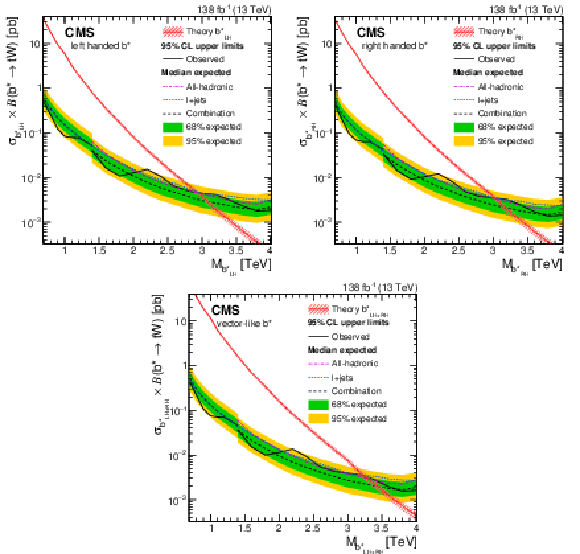
png pdf |
Figure 3:
Upper limits on the product of production cross section and branching fraction of the left-handed (upper left), right-handed (upper right) and vector-like (lower) b* hypotheses at 95% CL. Colored lines show the expected limits from the $\ell$+jets (dotted) and all-hadronic (dash-dotted) channels, where the latter start at b* masses of 1.4 TeV. The observed and expected limits from the combination are shown as solid and dashed black lines, respectively. The green and yellow bands show the 68 and 95% confidence intervals on the combined expected limits. The theoretical cross sections are shown as the red lines, where the uncertainties due to missing higher orders are depicted by shaded areas. |
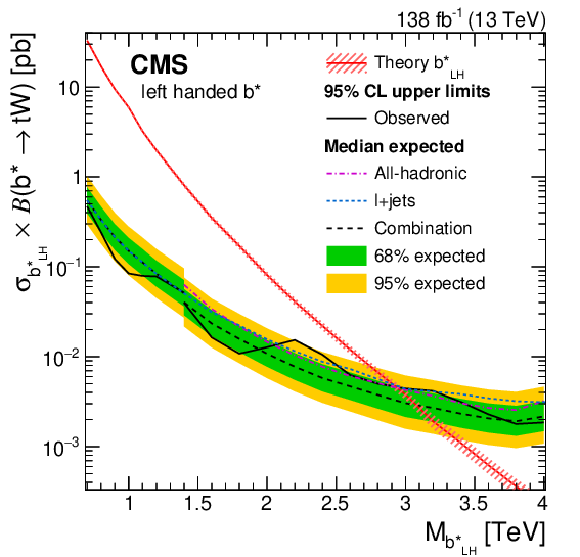
png pdf |
Figure 3-a:
Upper limits on the product of production cross section and branching fraction of the left-handed b* hypothesis at 95% CL. Colored lines show the expected limits from the $\ell$+jets (dotted) and all-hadronic (dash-dotted) channels, where the latter start at b* masses of 1.4 TeV. The observed and expected limits from the combination are shown as solid and dashed black lines, respectively. The green and yellow bands show the 68 and 95% confidence intervals on the combined expected limits. The theoretical cross section is shown as the red line, where the uncertainties due to missing higher orders are depicted by the shaded area. |

png pdf |
Figure 3-b:
Upper limits on the product of production cross section and branching fraction of the right-handed b* hypothesis at 95% CL. Colored lines show the expected limits from the $\ell$+jets (dotted) and all-hadronic (dash-dotted) channels, where the latter start at b* masses of 1.4 TeV. The observed and expected limits from the combination are shown as solid and dashed black lines, respectively. The green and yellow bands show the 68 and 95% confidence intervals on the combined expected limits. The theoretical cross section is shown as the red line, where the uncertainties due to missing higher orders are depicted by the shaded area. |

png pdf |
Figure 3-c:
Upper limits on the product of production cross section and branching fraction of the vector-like b* hypothesis at 95% CL. Colored lines show the expected limits from the $\ell$+jets (dotted) and all-hadronic (dash-dotted) channels, where the latter start at b* masses of 1.4 TeV. The observed and expected limits from the combination are shown as solid and dashed black lines, respectively. The green and yellow bands show the 68 and 95% confidence intervals on the combined expected limits. The theoretical cross section is shown as the red line, where the uncertainties due to missing higher orders are depicted by the shaded area. |

png pdf |
Figure 4:
Upper limits on the product of production cross section and branching fraction of the B+b (left) and B+t (right) production modes at 95% CL. Colored lines show the expected limits from the $\ell$+jets (dotted) and all-hadronic (dash-dotted) channels, where the latter start at B masses of 1.4 TeV. The observed and expected limits from the combination are shown as solid and dashed black lines, respectively. The green and yellow bands show the 68 and 95% confidence intervals on the combined expected limits. The theoretical cross sections are shown as the red and blue lines, where the uncertainties due to missing higher orders are depicted by shaded areas. |
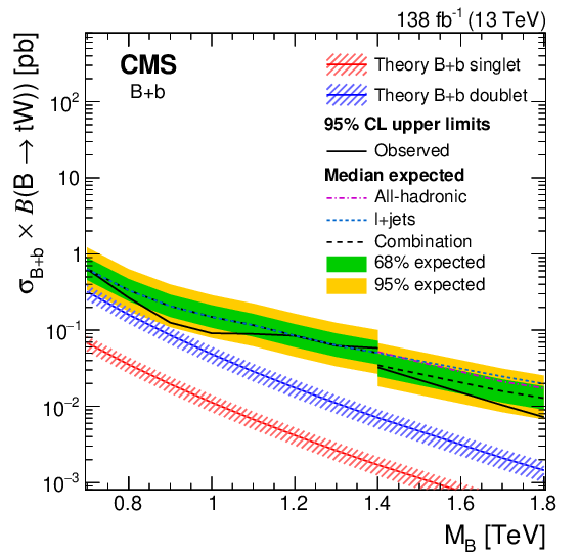
png pdf |
Figure 4-a:
Upper limits on the product of production cross section and branching fraction of the B+b production mode at 95% CL. Colored lines show the expected limits from the $\ell$+jets (dotted) and all-hadronic (dash-dotted) channels, where the latter start at B masses of 1.4 TeV. The observed and expected limits from the combination are shown as solid and dashed black lines, respectively. The green and yellow bands show the 68 and 95% confidence intervals on the combined expected limits. The theoretical cross sections are shown as the red and blue lines, where the uncertainties due to missing higher orders are depicted by shaded areas. |

png pdf |
Figure 4-b:
Upper limits on the product of production cross section and branching fraction of the B+t production mode at 95% CL. Colored lines show the expected limits from the $\ell$+jets (dotted) and all-hadronic (dash-dotted) channels, where the latter start at B masses of 1.4 TeV. The observed and expected limits from the combination are shown as solid and dashed black lines, respectively. The green and yellow bands show the 68 and 95% confidence intervals on the combined expected limits. The theoretical cross section is shown as the red line, where the uncertainties due to missing higher orders are depicted by the shaded area. |
| Tables | |
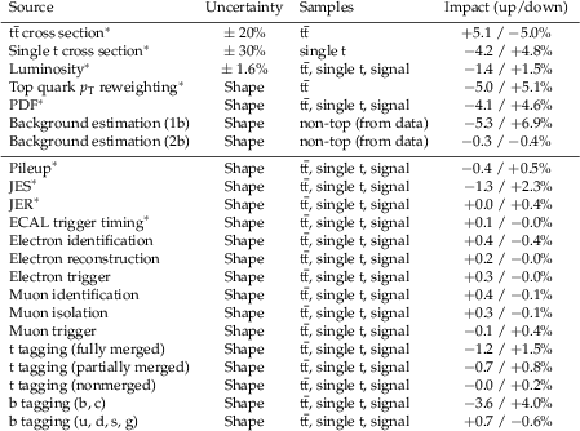
png pdf |
Table 1:
Summary of all considered sources of systematic uncertainties affecting the ${M_{\mathrm{t} \mathrm{W}}}$ distributions in the 1b and 2b categories of the $\ell$+jets channel. The source of the uncertainty is given in the first column. The second column indicates if the uncertainty results in a change of normalization or shape of the ${M_{\mathrm{t} \mathrm{W}}}$ distribution. The samples affected by a given uncertainty source are shown in the third column. The fourth column shows the impact of these uncertainties, estimated for an LH b* signal with a mass of 2.4 TeV. These are quantified by calculating the change in the fitted signal strength when a given parameter is displaced by $ \pm $1 standard deviation from its post-fit value, divided by the total uncertainty in the fitted signal. Uncertainties taken to be fully correlated across the three years are given in the upper part of the table. Uncertainties affecting both the $\ell$+jets and all-hadronic channels are marked by an asterisk. |
| Summary |
| A search for a heavy resonance decaying to tW in the final state with a lepton and a t-tagged jet has been presented. The data analyzed correspond to an integrated luminosity of 138 fb$^{-1}$ of proton-proton collisions collected at a center-of-mass energy of 13 TeV. Final states where the W boson decays leptonically and the top quark decay results in a single jet are probed. Compared to an earlier analysis of the all-hadronic final state, the lower reach of the analysis is extended from 1.4 down to 0.7 TeV, because of lower lepton trigger thresholds and the extended range in t quark transverse momentum provided by the Heavy Object Tagger with Variable R. Above 1.4 TeV a combination with the search in the all-hadronic final state has been performed. The dominant $\mathrm{t\bar{t}}$ background is constrained using a dedicated control region and the background from misidentified t jets is estimated from data. No significant excess of data over the background prediction is observed. Upper limits on the single production of a vector-like quark decaying to tW have been derived in the mass range of 0.7 to 1.8 TeV. The excited bottom quark b* hypotheses with left-handed, right-handed, and vector-like chiralities are excluded at 95% confidence level up to masses of 3.0, 3.0, and 3.2 TeV, respectively. The upper limits on the product of cross section and branching fraction represent the most stringent constraints on the b* model to date. |
| Additional Figures | |

png pdf |
Additional Figure 1:
Distribution of $\alpha $ as a function of $M_{{\mathrm {t}} {\mathrm {W}}}$ for the background estimation in the 1b category. Two different parametrizations are fitted to the distributions (solid lines) and the total uncertainty is shown as colored area. |

png pdf |
Additional Figure 2:
Distribution of $\alpha $ as a function of $M_{{\mathrm {t}} {\mathrm {W}}}$ for the background estimation in the 2b category. Two different parametrizations are fitted to the distributions (solid lines) and the total uncertainty is shown as colored area. |
| References | ||||
| 1 | H. Harari | Composite models for quarks and leptons | PR 104 (1984) 159 | |
| 2 | U. Baur, M. Spira, and P. M. Zerwas | Excited-quark and -lepton production at hadron colliders | PRD 42 (1990) 815 | |
| 3 | T. M. P. Tait and C. P. Yuan | Single top quark production as a window to physics beyond the standard model | PRD 63 (2000) 014018 | hep-ph/0007298 |
| 4 | J. Nutter, R. Schwienhorst, D. G. E. Walker, and J.-H. Yu | Single top production as a probe of B' quarks | PRD 86 (2012) 094006 | 1207.5179 |
| 5 | CMS Collaboration | The CMS experiment at the CERN LHC | JINST 3 (2008) S08004 | CMS-00-001 |
| 6 | ATLAS Collaboration | Search for single b*-quark production with the ATLAS detector at $ \sqrt{s}= $ 7 TeV | PLB 721 (2013) 171 | 1301.1583 |
| 7 | ATLAS Collaboration | Search for the production of single vector-like and excited quarks in the Wt final state in pp collisions at $ \sqrt{s} = $ 8 TeV with the ATLAS detector | JHEP 02 (2016) 110 | 1510.02664 |
| 8 | CMS Collaboration | Search for the production of an excited bottom quark decaying to tW in proton-proton collisions at $ \sqrt{s}= $ 8 TeV | JHEP 01 (2016) 166 | CMS-B2G-14-005 1509.08141 |
| 9 | CMS Collaboration | Search for a heavy resonance decaying to a top quark and a W boson at $ \sqrt{s} = $ 13 TeV in the fully hadronic final state | 2021. Submitted to JHEP | CMS-B2G-19-003 2104.12853 |
| 10 | J. Ellis | TikZ-Feynman: Feynman diagrams with TikZ | CPC 210 (2017) 103 | 1601.05437 |
| 11 | T. Lapsien, R. Kogler, and J. Haller | A new tagger for hadronically decaying heavy particles at the LHC | EPJC 76 (2016) 600 | 1606.04961 |
| 12 | A. J. Larkoski, I. Moult, and B. Nachman | Jet substructure at the Large Hadron Collider: A review of recent advances in theory and machine learning | Phys. Rep. 841 (2020) 1 | 1709.04464 |
| 13 | R. Kogler, B. Nachman, A. Schmidt (editors) et al. | Jet substructure at the Large Hadron Collider | Rev. Mod. Phys. 91 (2019) 045003 | 1803.06991 |
| 14 | J. A. Aguilar-Saavedra, R. Benbrik, S. Heinemeyer, and M. Pérez-Victoria | Handbook of vectorlike quarks: Mixing and single production | PRD 88 (2013) 094010 | 1306.0572 |
| 15 | A. De Simone, O. Matsedonskyi, R. Rattazzi, and A. Wulzer | A first top partner hunter's guide | JHEP 04 (2013) 004 | 1211.5663 |
| 16 | CMS Collaboration | HEPData record for this analysis | link | |
| 17 | CMS Collaboration | The CMS trigger system | JINST 12 (2017) P01020 | CMS-TRG-12-001 1609.02366 |
| 18 | CMS Collaboration | Performance of the CMS muon trigger system in proton-proton collisions at $ \sqrt{s} = $ 13 TeV | JINST 16 (2021) P07001 | CMS-MUO-19-001 2102.04790 |
| 19 | S. Frixione, P. Nason, and C. Oleari | Matching NLO QCD computations with parton shower simulations: The POWHEG method | JHEP 11 (2007) 070 | 0709.2092 |
| 20 | P. Nason | A new method for combining NLO QCD with shower Monte Carlo algorithms | JHEP 11 (2004) 040 | hep-ph/0409146 |
| 21 | S. Alioli, P. Nason, C. Oleari, and E. Re | A general framework for implementing NLO calculations in shower Monte Carlo programs: The POWHEG BOX | JHEP 06 (2010) 043 | 1002.2581 |
| 22 | S. Frixione, P. Nason, and G. Ridolfi | A positive-weight next-to-leading-order Monte Carlo for heavy flavour hadroproduction | JHEP 09 (2007) 126 | 0707.3088 |
| 23 | E. Re | Single-top Wt-channel production matched with parton showers using the POWHEG method | EPJC 71 (2011) 1547 | 1009.2450 |
| 24 | J. Alwall et al. | The automated computation of tree-level and next-to-leading order differential cross sections, and their matching to parton shower simulations | JHEP 07 (2014) 079 | 1405.0301 |
| 25 | J. Alwall et al. | Comparative study of various algorithms for the merging of parton showers and matrix elements in hadronic collisions | EPJC 53 (2008) 473 | 0706.2569 |
| 26 | M. Czakon and A. Mitov | Top++: A program for the calculation of the top-pair cross-section at hadron colliders | CPC 185 (2014) 2930 | 1112.5675 |
| 27 | N. Kidonakis | Two-loop soft anomalous dimensions for single top quark associated production with a W$^{-}$ or H$^{-}$ | PRD 82 (2010) 054018 | 1005.4451 |
| 28 | N. Kidonakis | Top quark production | in Helmholtz International Summer School on Physics of Heavy Quarks and Hadrons 2013 | 1311.0283 |
| 29 | M. Aliev et al. | HATHOR -- HAdronic Top and Heavy quarks crOss section calculatoR | CPC 182 (2011) 1034 | 1007.1327 |
| 30 | CMS Collaboration | Measurement of differential cross sections for top quark pair production using the lepton+jets final state in proton-proton collisions at 13 TeV | PRD 95 (2017) 092001 | CMS-TOP-16-008 1610.04191 |
| 31 | CMS Collaboration | Measurements of $ \mathrm{t\overline{t}} $ differential cross sections in proton-proton collisions at $ \sqrt{s}= $ 13 TeV using events containing two leptons | JHEP 02 (2019) 149 | CMS-TOP-17-014 1811.06625 |
| 32 | T. Sjostrand et al. | An introduction to PYTHIA 8.2 | CPC 191 (2015) 159 | 1410.3012 |
| 33 | CMS Collaboration | Event generator tunes obtained from underlying event and multiparton scattering measurements | EPJC 76 (2016) 155 | CMS-GEN-14-001 1512.00815 |
| 34 | CMS Collaboration | Investigations of the impact of the parton shower tuning in Pythia 8 in the modelling of $ \mathrm{t\overline{t}} $ at $ \sqrt{s}= $ 8 and 13 TeV | CMS-PAS-TOP-16-021 | CMS-PAS-TOP-16-021 |
| 35 | CMS Collaboration | Extraction and validation of a new set of CMS PYTHIA8 tunes from underlying-event measurements | EPJC 80 (2020) 4 | CMS-GEN-17-001 1903.12179 |
| 36 | NNPDF Collaboration | Parton distributions for the LHC Run II | JHEP 04 (2015) 040 | 1410.8849 |
| 37 | NNPDF Collaboration | Parton distributions from high-precision collider data | EPJC 77 (2017) 663 | 1706.00428 |
| 38 | CMS Collaboration | Measurement of the inelastic proton-proton cross section at $ \sqrt{s}= $ 13 TeV | JHEP 07 (2018) 161 | CMS-FSQ-15-005 1802.02613 |
| 39 | GEANT4 Collaboration | GEANT4--a simulation toolkit | NIMA 506 (2003) 250 | |
| 40 | Tracker Group of the CMS Collaboration | The CMS Phase-1 pixel detector upgrade | JINST 16 (2021) P02027 | 2012.14304 |
| 41 | CMS Collaboration | Performance of the CMS Level-1 trigger in proton-proton collisions at $ \sqrt{s} = $ 13 TeV | JINST 15 (2020) P10017 | CMS-TRG-17-001 2006.10165 |
| 42 | CMS Collaboration | Particle-flow reconstruction and global event description with the CMS detector | JINST 12 (2017) P10003 | CMS-PRF-14-001 1706.04965 |
| 43 | CMS Collaboration | Electron and photon reconstruction and identification with the CMS experiment at the CERN LHC | JINST 16 (2021) P05014 | CMS-EGM-17-001 2012.06888 |
| 44 | CMS Collaboration | Performance of the CMS muon detector and muon reconstruction with proton-proton collisions at $ \sqrt{s}= $ 13 TeV | JINST 13 (2018) P06015 | CMS-MUO-16-001 1804.04528 |
| 45 | M. Cacciari, G. P. Salam, and G. Soyez | The anti-$ {k_{\mathrm{T}}} $ jet clustering algorithm | JHEP 04 (2008) 063 | 0802.1189 |
| 46 | M. Cacciari, G. P. Salam, and G. Soyez | FastJet user manual | EPJC 72 (2012) 1896 | 1111.6097 |
| 47 | CMS Collaboration | Technical proposal for the Phase-II upgrade of the Compact Muon Solenoid | CMS-PAS-TDR-15-002 | CMS-PAS-TDR-15-002 |
| 48 | CMS Collaboration | Performance of electron reconstruction and selection with the CMS detector in proton-proton collisions at $ \sqrt{s} = $ 8 TeV | JINST 10 (2015) P06005 | CMS-EGM-13-001 1502.02701 |
| 49 | D. Krohn, J. Thaler, and L.-T. Wang | Jets with variable R | JHEP 06 (2009) 059 | 0903.0392 |
| 50 | M. Cacciari and G. P. Salam | Pileup subtraction using jet areas | PLB 659 (2008) 119 | 0707.1378 |
| 51 | Y. L. Dokshitzer, G. D. Leder, S. Moretti, and B. R. Webber | Better jet clustering algorithms | JHEP 08 (1997) 001 | hep-ph/9707323 |
| 52 | M. Wobisch and T. Wengler | Hadronization corrections to jet cross-sections in deep inelastic scattering | in Proceedings of the workshop on Monte Carlo generators for HERA physics, Hamburg 1998 | hep-ph/9907280 |
| 53 | M. Stoll | Vetoed jet clustering: The mass-jump algorithm | JHEP 04 (2015) 111 | 1410.4637 |
| 54 | CMS Collaboration | Identification of heavy, energetic, hadronically decaying particles using machine-learning techniques | JINST 15 (2020) P06005 | CMS-JME-18-002 2004.08262 |
| 55 | CMS Collaboration | Pileup mitigation at CMS in 13 TeV data | JINST 15 (2020) P09018 | CMS-JME-18-001 2003.00503 |
| 56 | D. Bertolini, P. Harris, M. Low, and N. Tran | Pileup per particle identification | JHEP 10 (2014) 059 | 1407.6013 |
| 57 | CMS Collaboration | Jet energy scale and resolution in the CMS experiment in pp collisions at 8 TeV | JINST 12 (2017) P02014 | CMS-JME-13-004 1607.03663 |
| 58 | J. Thaler and K. Van Tilburg | Identifying boosted objects with $ {N} $-subjettiness | JHEP 03 (2011) 015 | 1011.2268 |
| 59 | J. Thaler and K. Van Tilburg | Maximizing boosted top identification by minimizing $ {N} $-subjettiness | JHEP 02 (2012) 093 | 1108.2701 |
| 60 | CMS Collaboration | Performance of b tagging algorithms in proton-proton collisions at 13 TeV with Phase 1 CMS detector | CDS | |
| 61 | CMS Collaboration | Performance of missing transverse momentum reconstruction in proton-proton collisions at $ \sqrt{s} = $ 13 TeV using the CMS detector | JINST 14 (2019) P07004 | CMS-JME-17-001 1903.06078 |
| 62 | CMS Collaboration | Search for massive resonances decaying into WW, WZ or ZZ bosons in proton-proton collisions at $ \sqrt{s} = $ 13 TeV | JHEP 03 (2017) 162 | CMS-B2G-16-004 1612.09159 |
| 63 | CMS Collaboration | Precision luminosity measurement in proton-proton collisions at $ \sqrt{s} = $ 13 TeV in 2015 and 2016 at CMS | EPJC 81 (2021) 800 | CMS-LUM-17-003 2104.01927 |
| 64 | CMS Collaboration | CMS luminosity measurement for the 2017 data-taking period at $ \sqrt{s} = $ 13 TeV | CMS-PAS-LUM-17-004 | CMS-PAS-LUM-17-004 |
| 65 | CMS Collaboration | CMS luminosity measurement for the 2018 data-taking period at $ \sqrt{s} = $ 13 TeV | CMS-PAS-LUM-18-002 | CMS-PAS-LUM-18-002 |
| 66 | J. Butterworth et al. | PDF4LHC recommendations for LHC Run II | JPG 43 (2016) 023001 | 1510.03865 |
| 67 | CMS Collaboration | Identification of heavy-flavour jets with the CMS detector in pp collisions at 13 TeV | JINST 13 (2018) P05011 | CMS-BTV-16-002 1712.07158 |
| 68 | J. S. Conway | Incorporating nuisance parameters in likelihoods for multisource spectra | in Proceedings, workshop on statistical issues related to discovery claims in search experiments and unfolding (PHYSTAT 2011) | 1103.0354 |
| 69 | R. J. Barlow and C. Beeston | Fitting using finite Monte Carlo samples | CPC 77 (1993) 219 | |
| 70 | T. Junk | Confidence level computation for combining searches with small statistics | NIMA 434 (1999) 435 | hep-ex/9902006 |
| 71 | A. L. Read | Presentation of search results: The CL$ _\text{s} $ technique | JPG 28 (2002) 2693 | |
| 72 | G. Cowan, K. Cranmer, E. Gross, and O. Vitells | Asymptotic formulae for likelihood-based tests of new physics | EPJC 71 (2011) 1554 | 1007.1727 |
| 73 | A. Carvalho et al. | Single production of vector-like quarks with large width at the Large Hadron Collider | PRD 98 (2018) 015029 | 1805.06402 |
| 74 | CMS Collaboration | Search for single production of vector-like quarks decaying to a top quark and a W boson in proton-proton collisions at $ \sqrt{s} = $ 13 TeV | EPJC 79 (2019) 90 | CMS-B2G-17-018 1809.08597 |

|
Compact Muon Solenoid LHC, CERN |

|

|

|

|

|

|